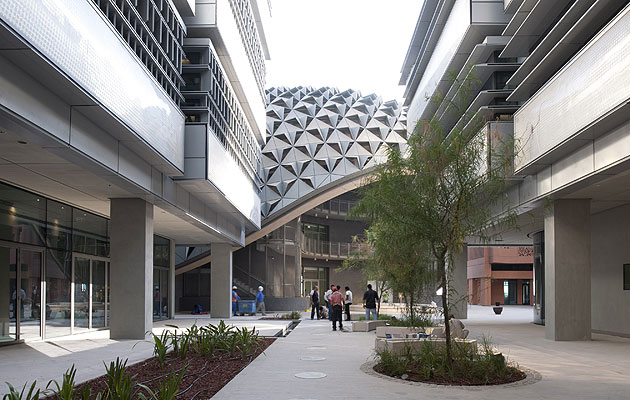|
|
||
|
Foster + Partners has completed the Masdar Institute in Abu Dhabi, a postgraduate research centre for the state-run renewable energy company. It is the first phase to be built of Foster’s masterplan for a carbon-neutral city, and consists of laboratories, libraries and halls of residence for students. The building’s performance statistics are impressive: it is entirely self-sufficient in electricity, energy and water consumption are low and its roof is covered in a field of photovoltaic panels which also provide shade to the outdoor spaces between the buildings. It’s an exemplar for the ecological side of Foster’s work: low-energy and sustainable, as opposed to all those carbon-hungry airports and super-tall towers that the firm also designs. This contradiction is in keeping with the character of Abu Dhabi, the richest of the United Arab Emirates, which is ploughing the money it earns selling petroleum to the world into these experiments in low-carbon living. “These projects will have an impact on the sustainable technologies at our disposal as the development progresses,” says Gerard Evenden, senior partner at Foster, referring to how the institute itself is a testing ground for the research that’s going on inside. Formally, the building has a strange quality. On the one hand, it’s recognisably Foster – the steel and glass boxes, the tasteful details, and the now obligatory blobby shape. But the design is also filled with Arabic signifiers: much of the facade shading is provided by abstracted versions of traditional mashrabiya screens, appearing both historic and contemporary, while other local forms such as wind towers make an appearance. The centre also manages to avoid almost completely that classic shade of cool grey that so often characterises a Foster building. This high-tech historicism may be quite old news (just recall the mashrabiya from Jean Nouvel’s 1987 Institut du Monde Arabe in Paris), but we’ve not really seen this strange mix from Foster before. It’s not just local pastiche, however, as Evenden explains: “We studied settlements that pre-dated electricity and relied on passive environmental controls to create comfort. If we can reduce the energy needed to cool a building in a desert, then we can do it anywhere.” Foster himself wants the building to be seen as significant, pointing out that “many have dreamed of a utopian project that would be solar powered”, and he’s previously described this project as perhaps the one that best embodies the legacy of Buckminster Fuller – all optimism through high technology. It is with designs like these that Foster + Partners is at its best, even if Evenden wants to downplay the utopianism: “Masdar City sets out to achieve something extraordinary that hasn’t been done before. But it is not idealistic … It will be an oasis, not a mirage.” |
Image Nigel Young, Foster + Partners
Words Douglas Murphy |
|
|
||
|
|
||



















